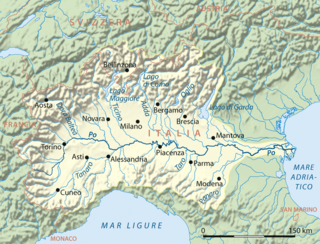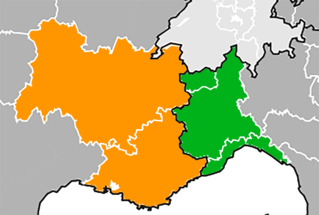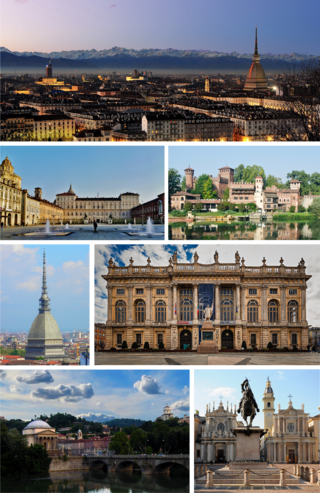
Piedmont is a region of Northwest Italy, one of the 20 regions of the country. It borders the Liguria region to the south, the Lombardy and Emilia-Romagna regions to the east and the Aosta Valley region to the northwest; it also borders Switzerland to the northeast and France to the west. It has an area of 25,402 km2 (9,808 sq mi) making it the second largest region of Italy after Sicily and a population of 4,269,714 as of 31 January 2021. The capital of Piedmont is Turin.

Padania is an alternative name and proposed independent state encompassing Northern Italy, derived from the name of the Po River, whose basin includes much of the region, centered on the Po Valley, the major plain of Northern Italy.

Filippo Juvarra was an Italian architect, scenographer, engraver and goldsmith. He was active in a late-Baroque architecture style, working primarily in Italy, Spain, and Portugal.

The Gallo-Italic, Gallo-Italian, Gallo-Cisalpine or simply Cisalpine languages constitute the majority of the Romance languages of northern Italy. They are Piedmontese, Lombard, Emilian, Ligurian, and Romagnol. Although most publications define Venetian as part of the Italo-Dalmatian branch, both Ethnologue and Glottolog group it into the Gallo-Italic languages.

Northern Italy is a geographical and cultural region in the northern part of Italy. It consists of eight administrative regions: Aosta Valley, Piedmont, Liguria, Lombardy, Emilia-Romagna, Veneto, Friuli-Venezia Giulia and Trentino-Alto Adige. As of 2014, its population was 27,801,460. Rhaeto-Romance and Gallo-Italic languages are spoken in the region, as opposed to the Italo-Dalmatian languages spoken in the rest of Italy. The Venetian language is sometimes considered to be part of the Italo-Dalmatian languages, but some major publications such as Ethnologue and Glottolog define it as Gallo-Italic.

Italy has a very broad and diverse architectural style, which cannot be simply classified by period or region, due to Italy's division into various small states until 1861. This has created a highly diverse and eclectic range in architectural designs. Italy is known for its considerable architectural achievements, such as the construction of aqueducts, temples and similar structures during ancient Rome, the founding of the Renaissance architectural movement in the late-14th to 16th century, and being the homeland of Palladianism, a style of construction which inspired movements such as that of Neoclassical architecture, and influenced the designs which noblemen built their country houses all over the world, notably in the United Kingdom, Australia and the United States of America during the late-17th to early 20th centuries.
An Albergo was a term used during the Renaissance to indicate an organizational structure in which several families linked by blood or a common interest banded together. The different families derived economic, political, or military support from each other. They usually lived near each other and attended the same churches.

The Alps–Mediterranean Euroregion was created on 10 July 2007 between three Italian regions and two French regions. It has an area of about 110,460 km2 and more than 17 million inhabitants. The largest Italian cities are Turin and Genoa and the largest French cities are Lyon, Marseille and Nice near Monaco.

Turin is a city and an important business and cultural centre in Northern Italy. It is the capital city of Piedmont and of the Metropolitan City of Turin, and was the first Italian capital from 1861 to 1865. The city is mainly on the western bank of the Po River, below its Susa Valley, and is surrounded by the western Alpine arch and Superga Hill. The population of the city proper is 847,287 while the population of the urban area is estimated by Eurostat to be 1.7 million inhabitants. The Turin metropolitan area is estimated by the OECD to have a population of 2.2 million.

Torino Porta Nuova railway station is the main railway station of Turin, northern Italy. It is the third busiest station in Italy for passenger flow after Rome Termini and Milan Central, with about 192,000 journeys per day and 70 million travellers a year and a total of about 350 trains per day. Porta Nuova is a terminal station, with trains arriving perpendicularly to the facade. The station is located in Corso Vittorio Emanuele II, right in front of Piazza Carlo Felice.

Italian Baroque architecture refers to Baroque architecture in Italy.
Italian Rococo interior design refers to interior decoration in Italy during the Rococo period, which went from the early 18th century to around the 1760s.
Italian Neoclassical interior design refers to furnishing and interior decorating trends in Italy which occurred during the Neoclassical period

This timeline shows the periods of various architectural styles in the architecture of Italy. Italy's architecture spans almost 3,500 years, from Etruscan and Ancient Roman architecture to Romanesque, Gothic, Renaissance, Baroque, Rococo, Neoclassical, Art Nouveau, Fascist, and Italian modern and contemporary architecture.

Torino Lingotto railway station is one of the main stations serving the city and comune of Turin, capital of the region of Piedmont, northwestern Italy. The Torino Lingotto metro station is located nearby, and opened on March 6, 2011.

Benedetto Innocenzo Alfieri was an Italian architect, a representative of the late-Baroque or Rococo style.

The following outline is provided as an overview of and topical guide to Turin:
Sogegross Group is an Italian supermarket company operating in wholesale trade under the cash and carry formula as Sogegross and in retail under the brands Basko, Doro Supermercati, and Ekom.
Noemi Gabrielli was an Italian art historian, superintendent, and a museologist.


















